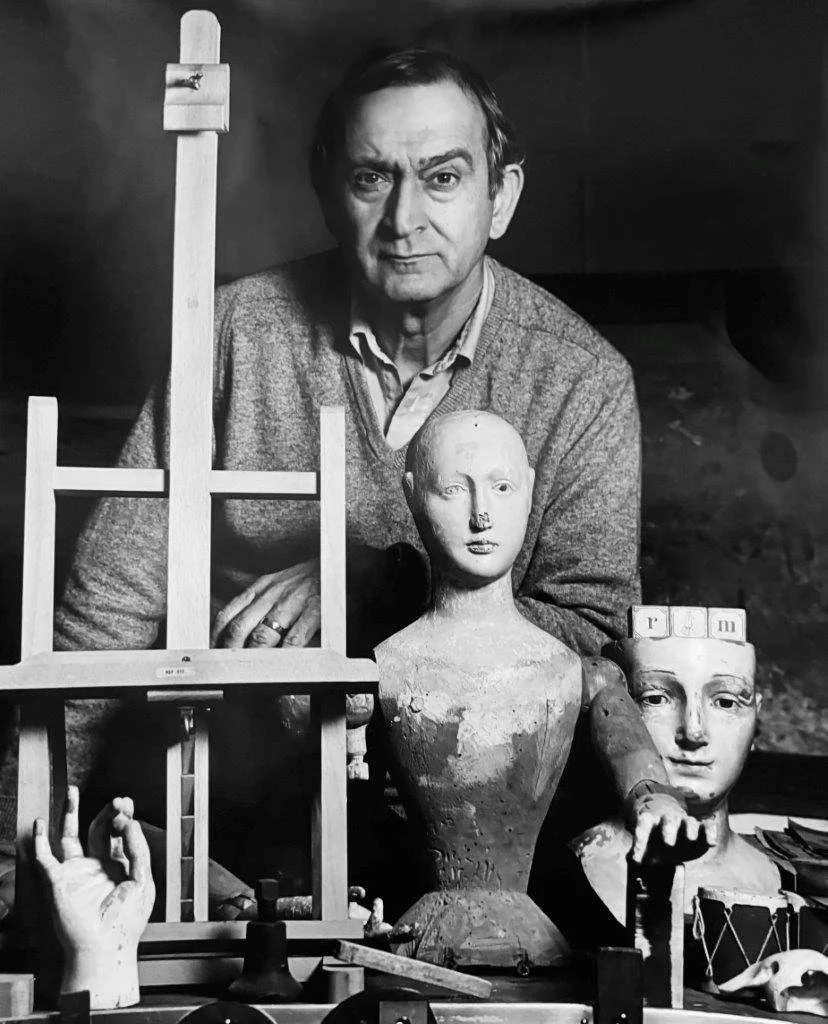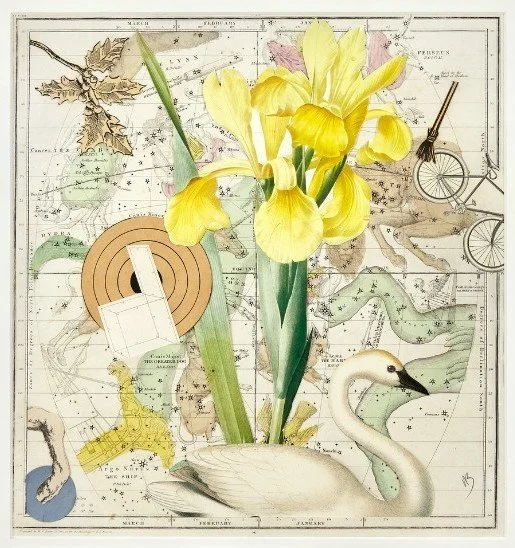Artscope: Varujan Boghosian’s Magical Oddities are a Delight
By Rachel Flood Page, Artscope
Whimsical and playful, surreal and profound, "Fragments of Memory" at the Armenian Museum of America in Watertown firmly places Armenian American artist Varujan Boghosian in the company of influential assemblage artists like Joseph Cornell, Hannah Höch, Kurt Schwitters, Max Ernst, and Salvador Dali. Art lovers who appreciate oddities, hidden stories in nooks and crannies, and finding something new every time they take a second look, will delight in digging deep into the incredible portfolio of Boghosian.
Raised in Connecticut by working class parents, young Boghosian was inspired by his teacher, and poet, Constance Carrier, who led him to a love of stories. After serving in the United States Navy during World War II, he attended art school in Boston, Italy and under the tutelage of Josef Albers at Yale. Throughout his career, his works have been exhibited in museums across the country and in public collections at the Metropolitan Museum of Art, the Museum of Modern Art, the Whitney Museum of American Art, the New York Public Library, and the Philadelphia Museum of Art. A beloved member of the Provincetown artistic community, his work was often on view in friend Berta Walker's gallery. Boghosian was earnestly, and devotedly, an educator for much of his life, his longest tenure at Dartmouth College, from 1968 to 1996.
Varujan Boghosian
As the son of Armenian immigrants who left their home to escape a genocide, it is not a surprise that Boghosian found preciousness in lost or discarded things. His constructions are clearly so lovingly created, adding an additional layer of profundity to his enigmatic work. He called himself a "junk collector" but really, he was a junk connoisseur, seeking out objects that held meaning for him, tied to the themes he wanted to explore. He often collected multiples of the same thing — including butterflies, children's blocks, letters, human figures, and maps.
"Fragments of Memory" includes a video of Boghosian where the artist is interviewed while enthusiastically rifling through a large warehouse of second-hand objects, stating: "You never have enough, the more you have, the more opportunities you have." The video's inclusion was a wonderful choice by curator Ryann Casey, allowing Boghosian's kindness, humor, and curious nature to inform the visitor's experience.
Describing his process, friends noted that Boghosian would often work on multiple pieces at once, some taking a considerable amount of time to be finished. Every construction for him was a journey of waiting, of finding, of deciding, and of finally placing the object, or fragment of a print, or piece of wallpaper, exactly where it was meant to be. Poet Stanley Kunitz wrote the poem "Chariot" in 1989 about his friend's workshop, and likely the beginnings of what became "Variation of a Constellation," on display in this exhibition,
"Here everything waits to be renewed. That horse-age wagon wheel propped in the corner against an empty picture-frame even in its state of disrepair, minus three spokes, looks poised for flight."
While entirely amiable, one must have a sense of humor to be as beloved a professor as he was, and Boghosian's approach was meticulous. Many of his constructions contain intricate mosaics, such as the perfectly puzzled backdrop of "The Heart of the Matter," 1992. This precision also appears in his watercolors and drawings. In an early work from 1954, the watercolor "Perugia," bright blocks of vibrant color in a geometric pattern are framed not by lines, but by hundreds of tiny dots creating the borders of the image. Boghosian's pointillist approach appears in his "Studies for Orpheus" from 1963. The physicality of these pieces is palpable, tiny nails hammered close together in concentric patterns on a wooden hat block - one can imagine the artist bent over and dexterously tapping in each individual nail with intense focus, resulting in something quite beautiful.
Heart of the Matter
"Studies for Orpheus" evokes another theme throughout his work, that of constellations, and in particular, maps of stars that present the images from myth that inspired their naming such as an "Untitled" collage where he placed one of Dali's painted illusory figures, a kind of assemblage itself, in front of an illustrated constellation map. Another piece of Dali's work appears in "Combat," two fighting figures, a fragment of Dali's "Le Spectre des Sex Appeal," encircled by a swirl of Boghosian's meticulously placed white dots, reminiscent of spiraling light patterns in Otto Piene's work.
Boghosian's interest in mythology, and the story of Orpheus and Eurydice in particular, is well known, and the imagery that he imagined representing the tale is threaded throughout his constructions. In his two- and three-dimensional works, Orpheus is often represented by a bird, his love for Eurydice by a butterfly, or, in the case of "The Heart of the Matter," 1992, two intertwined hearts. This piece also contains an ominous depiction of Charon (or perhaps Hades), ferryman of the dead, a welded assemblage of a bronze face, collar, and horns. This being is seen in other works, such as in "Variation of a Constellation" in the center of the wooden wheel.
Boghosian also presents Orpheus as a figure wearing a conical hat, seen in "Breaking Through (Black)," and "Four Short Stories," 1993. Contemporaries like Joseph Cornell were drawn to creating a contained collection of objects within a frame, disrupting the typical flat painting with layers of objects, even inviting viewers to touch and physically interact with the piece. Boghosian's constructions don't need to be invited to interact with you, they are already on your plane, even when encased in a frame they still pop out of it.
In "Breaking Through (Black)," Boghosian stretched a worn rectangle of black painted canvas into a wooden frame and intentionally ripped the fabric to reveal the figure of Orpheus emerging from the darkness. The hat reaches higher than the frame, emphasizing the moment of his return to earth, likely seconds before his fateful mistake. Next to this work in striking juxtaposition, "Breaking Through," 1998, depicts Orpheus bursting through the canvas into a beautifully constructed collage of objects in vibrant reds and blues against plain wood, again showing the figure returning to the world of color and life.
Something inescapable when interacting with Boghosian's constructions is his playfulness and whimsy. "Rainbow, Rainbow, Rainbow," 2003, is a diverting combination of a fish shaped baking dish, and a child's stained-glass, framed by the word "rainbow" repeatedly spelled out in tiles. In "Over the Top," 2012, an acrobat launches himself over a wooden top (get it?). If you liked that one, he'll tell you another in "Locked Trunk," an elephant figurine with a padlock fused to its nose. Boghosian also enjoyed poking fun at fellow artists. Poor Van Gogh, Boghosian's portrait of the artist, "Vincent (Ear and Letters)," 2006, is simply that, an ear, and cut out letters spelling 'Vincent' over and over again. "For Max Ernst," 2013, is a collage of a paper doll in front of geometric wallpaper. The doll's face is nothing but a white circle, perhaps referencing Ernst's tendency to obscure, or even completely remove women's faces in his paintings and collages. "Swan for Marcel," 2011, is one of Boghosian's more cluttered collages, a collection of images hinting at Duchamp's found objects.
Rainbow, Rainbow, Rainbow
Over the Top
Swan for Marcel
Boghosian's work dances between and through the movements of Dada, assemblage art, and surrealism in conversation with artists like Cornell, Ernst, Duchamp, Dali and others. He is also a style completely unto himself. Viewers not only see glimpses of the artist in the constructions he creates, but in two self-portraits, "Self Portrait of the Artist as a Young Man," 1989, and "Self Portrait as a Lion," 2006, two very different choices by Boghosian in self-representation. The earlier portrait is a small child with patched clothes, hard at work constructing with bright blue paper and a butterfly, in the later one he presents himself as the assemblage, a man with a lion's head.
Self Portrait as a Lion
"Fragments of Memory" is a profound delight. Visitors are inspired to move back and forth between each piece, finding details and thinking where have I seen that before? What does it mean when it's here in relation with this object, versus another one? There's another butterfly! Every fragment he collected and used in his constructions had a story already, he just told it a little differently. Along with the objects the stories themselves became his materials, everything was endowed with meaning, and in true enigmatic fashion, he chose whether or not to show you all of it, keeping us, his students, curious and inspired.
Reposted with permission from Artscope Magazine.






